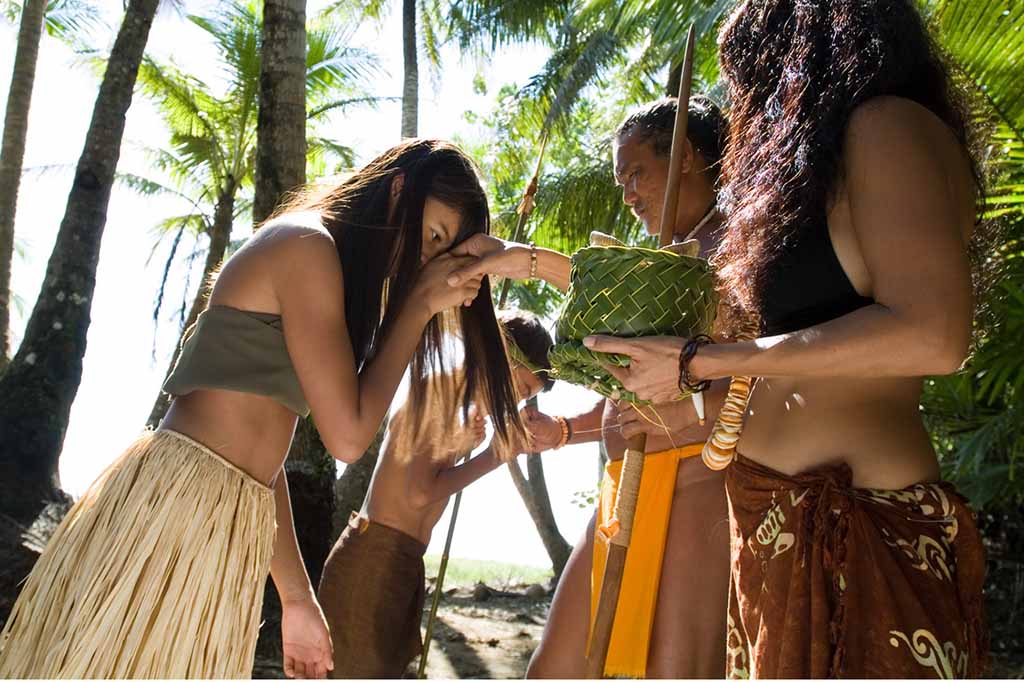Familia

Clans are the social base
Familia, a Spanish word meaning family, has a more inclusive definition in CHamoru. The term familia includes not only one’s immediate family members, but the branches of families who make up one’s clan as well. Several families who have an ancestor in common make up a clan.
In CHamoru society, families and clans have always been a central part of an individual’s world. From birth until death, the familia provides a sense of identity, a social base, a support system, and defines one’s social status, responsibilities and obligations. CHamorus are understood within the context of their familia. An essential part of forming a relationship is figuring out who each other’s relatives are as a means of identifying mutual obligations of reciprocity shared within and between clans – a key element of CHamoru social and cultural structure.
Familia siha or family members, consist of saina, famagu’on, tatan bihu, nanan biha, tiha, tihu, primu, prima, (parents, children, grandfather, grandmother, aunties, uncles, and male and female cousins, respectively)—and extends to embrace in-laws and adopted relations. It also includes close relationships, such as those formed and maintained with dear friends, and nina and ninu (godmother and godfather, respectively).
It is still fairly common for families to live close to one another—in a family compound or in the same village. However, it is also true that it is becoming more common to live more separately in nuclear family units and to live some distance apart (there are currently many more CHamorus living stateside than on Guam and in the Northern Mariana Islands) though that does not reduce their obligations to each other.
Social and economic unit
Familia siha are cooperative social and economic units. Family members are to share, help and protect each other without fail, and plan and commemorate life celebrations with each other. Each member has key roles and responsibilities. These are determined by age and gender, although other factors are considered as well, such as having particular talent, knowledge, skill, or resource available. With increasing seniority in the familia, comes increasing responsibility – managing familia affairs and tasking familia members with specific duties. Familia members recognize and defer to their elders’ authority.
Traditionally, familia leaders and/or elders make many of the family decisions. In ancient times, marriages would be arranged and negotiated between clan leaders. Up until recent decades, courtship and marriage customarily required family elders’ approval. In more recent years however, children have been be allowed to have greater participation in the decision-making that affects them.
Sisters and brothers
Ancient CHamorus were matrilineal, with the sister and brother as heads of the familia. Children belonged to their mother’s clan. This meant that children traced their lineage and inherited their rights to land, resources, and the obligations of the clan from their mother’s line.
Once married, a woman would join her husband on the land of his mother’s clan. Once children reached adolescence, they would be returned to their mother’s clan and it was their maternal uncles, not their fathers, who would raise them, teaching them skills needed as adults. It was when they returned to their mother’s clan that they would take on their roles within that clan and where their life circumstances would be determined. Over time, patriarchal Spanish and American family practices were introduced, some of which have since been incorporated into CHamoru culture. For some families, mothers and fathers share leadership responsibilities. For others, grandparents or other elders remain at the head of more extended family networks. CHamoru families today consider both sides of the family as equally important.
Value systems
Families can gain reputations for their integrity; levels of generosity; sense of tradition; or types of skills, knowledge or professions. Each member represents their familia. Their actions not only speak for themselves as individuals, but can earn pride and distinction for the entire familia.
Since ancient times, one of the most important ways of earning distinction for CHamorus is to have family members that properly demonstrate the values of inafa’maolek, respetu, mamåhhlao, mannginge’ and chenchule’ (being a caring, supportive family with proper senses of respect, humility, respect for elders shown by kissing their hand and participating in the family’s reciprocal networks). Conversely, a member’s ‘improper’ actions can also bring a sense of shame to the familia. CHamoru families can also feel compelled to come to the aid or defense of its members. Familia debts owed or incurred are passed on to succeeding generations.
For further reading
Chamorro Heritage, A Sense of Place: Guidelines, Procedures and Recommendations For Authenticating Chamorro Heritage. The Hale’-ta Series. Hagåtña: Department of Chamorro Affairs, Research, Publication and Training Division, 2003.
Cunningham, Lawrence J. Ancient Chamorro Society. Honolulu: Bess Press, 1992.
Inafa’ maolek: Chamorro Tradition and Values. The Hale’-ta Series. Hagåtña: Political Status Education Coordinating Commission, 1996.
Kasperbauer, Carmen A. “The Chamorro Culture.” In Kinalamten Pulitikåt: Siñenten I Chamorro (Issues in Guam’s Political Development: The Chamorro Perspective). The Hale’-ta Series. Hagåtña: Political Status Education Coordinating Commission, 1996.
Thompson, Laura M. Guam and Its People. With a Village Journal by Jesus C. Barcinas. 3rd ed. New Jersey: Princeton University Press, 1947.